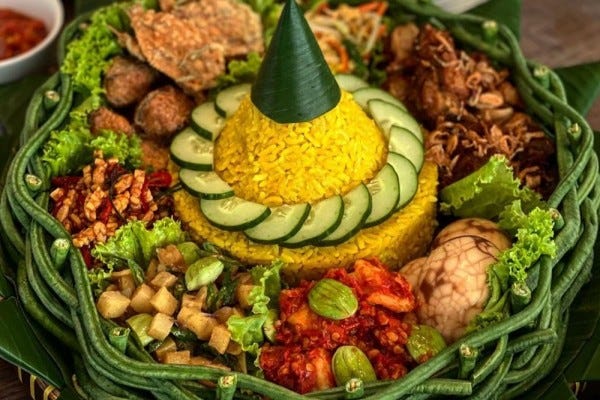Every last Monday of the month, we provide you with a free round-up issue, called Sarapan Pagi. We hope you’ll find this second issue just as fun!
We take our food seriously in Southeast Asia.
In fact, our love for food may arguably be the one thing that unites us all. While the pandemic makes it increasingly hard to gather with friends, food is still best enjoyed in good company.
As a matter of fact, some meals cannot be eaten alone. Our second issue of Sarapan Pagi looks at how particular meals in Southeast Asia are meant specifically for sharing.
Communal Food in Southeast Asia
1. Nasi Tumpeng/Sangu Tumpeng
– Java, Indonesia

Source: IDN Times
This mountain-shaped rice dish is often decorated with condiments and garnishes on the side. Every element and section of the tumpeng has its own meaning and symbolises giving thanks to the Almighty. The seven side dishes too represent a value, sometimes linked to the way it sounds (also known as homophones). For example, the number “pitu” or seven, is associated with “pitulungan” or help. Sounds good? Tastes even better. Often reserved for birthdays, anniversaries and special occasions like Javanese ceremonies known as selametan, it is usually yellow rice cooked with aromatic herbs, tantalising spices and sweet coconut milk.
2. Paelya
– Philippines

Source: Philippineslifestyle.com
An influence from the Spanish Valencian paella, this Filipino dish uses turmeric (luyang dilaw), or anatto (achuete) in place of saffron. Sometimes, the soft-scented pandan and tomato is added for flavour. Interestingly, what makes it distinctively Filipino is its use of malangkit, a local glutinous rice that makes it soft and gooey. Cooked in a wok or a wide shallow pan, paelya is considered only for special occasions such as Christmas dinners and is cooked in big portions enjoyed by the family.
3. Yusheng/Lo Hei
– Chinese diaspora in Southeast Asia

Source: Cardable
Yusheng (or “Prosperity Toss”) is a fish salad mixed together by friends and family to usher in the Chinese New Year. Its mixed sauce often comprises plum sauce, rice vinegar, kumquat paste and sesame oil. Like nasi tumpeng, many of the ingredients are conflated with its homophonic sounds – i.e. fish is tossed in as it sounds like the Mandarin word for “abundance”. Each enthusiastic toss is accompanied by shouting out these words in hopes of seeking fortune and success – placing more fun in the tossing, than the actual eating!
What’s a memorable shared meal you miss during this time?
Read more about festive food across Southeast Asia:
· Fish or Luck? How homophones shape Chinese New Year practices
· The Diverse Cuisine of Southeast Asia
What’s for Breakfast Today?
August–September are months filled with national days (for Indonesia, Singapore, Vietnam, and Malaysia). To reflect on nation-building and tensions within different countries, we list below thoughtful reads about Southeast Asia’s past and future:
· Will you listen? Perspectives from young Thais about the country’s future
by Wanpen Pajar, Southeast Asia Globe
Pro-democracy demonstrations in Thailand reveal how youths are increasingly stirred for change and reform in the monarchy and government.
· The Bloodied Arm of the Law
by Foong Li Mei, New Naratif
This comprehensive infographic shows the harrowing numbers of Malaysia’s police violence and deaths in custody, pushing us to reflect on the work that still needs to be done in Malaysia.
· What was Singapore like 100 years ago? (Education)
by James Lui and Loh Pei Ying, Kontinentalist
This concise and highly visual article takes a look at Singapore’s colonial education landscape in the 1920s.
· Behind the Dream: A Family Broken by a Jade Mining Disaster
by Shawanang, New Naratif
This comic explores how miners put their lives at risk in Myanmar. Shawanang’s fictional story is inspired by real events – where over 170 people died in a landslide in Hpakant’s jade mines just last month.
We hope you benefited from this short and sweet issue. Keep a look out for the next one in September for more content about Southeast Asia!
Sampai ketemu!
Cari Makna team
Like what you see? Invite friends and family to subscribe to Cari Makna.

